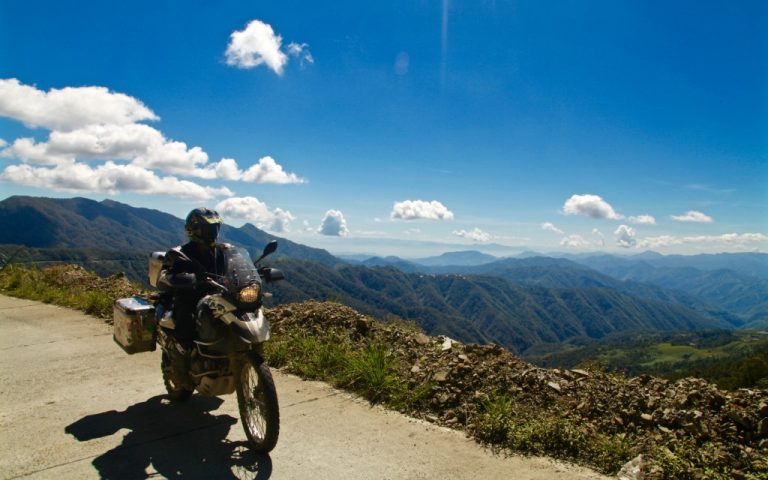In an effort to discover the best of the Philippines, Ian Neubauer takes an adventure across the Pan-Philippine Highway.
Traffic signs in the Philippines are mostly suggestive. But the one I see riveted to a pedestrian overpass on a road heading out of Manila takes the cake: ‘Stay in your lane’. There are five marked lanes yet nearly twice as many rows of cars, buses and trucks fighting for space, plus thousands of scooters filtering between them.
With panniers fitted onto my Beamer, my ability to filter is limited, and the best I can do is putter along, inhaling all kinds of noxious fumes as sweat runs down my back and pools in my butt crack while my eardrums are hammered by horns.
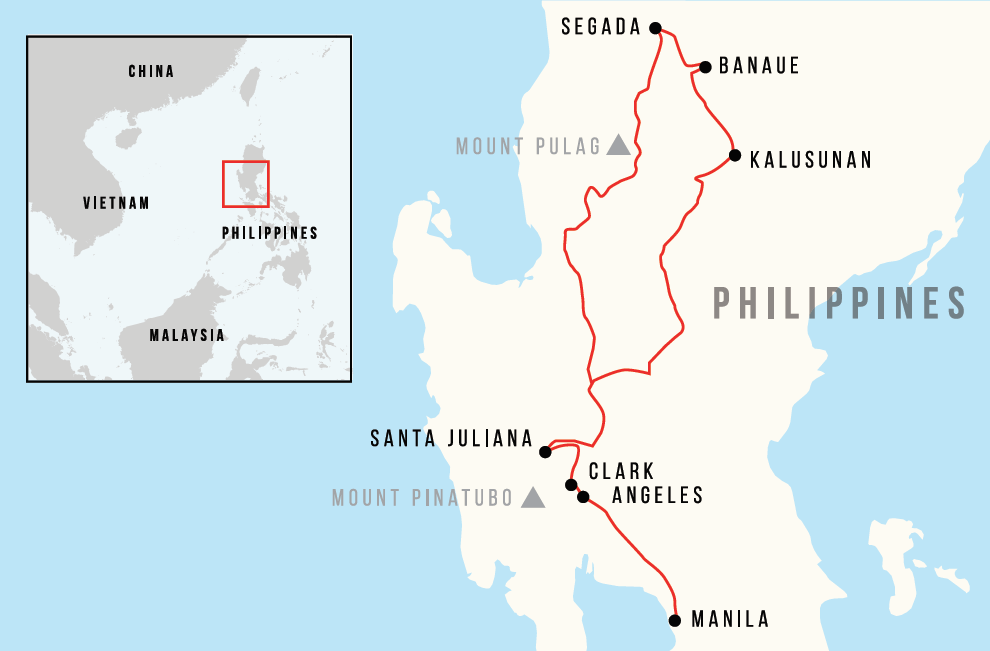
Suddenly I hear a siren. It’s an ambulance begging to be let through the jam. As it passes me I sneak behind it and follow tightly in the path that clears in its wake, fighting off annoying scooters trying to get in on the action as I power towards a motorway that will take me far from this traffic (and smog) choked cesspool of a city to the misty mountains of Luzon, the largest of the 7,100 islands of the Philippines.
“There are so many beautiful places to ride in this county,” says Philippe Saubier of PAR Motorrad, the Manila-based motorbike touring company whose Beamer I’m using. “But the mountains are special because they are so unexpected for the Philippines.”
Red lights and volcanoes
I get a good run on the motorway until I reach the city of Angeles 50 miles to the north. Angeles is basically one big red-light district that gained notoriety servicing army brats from Clark Air Base down the road since the end of WWII. Clark was the largest U.S. military facility outside North America. But in 1991, nearby Mt Pinatubo exploded causing the second-largest terrestrial eruption of the 20th century.
The Yanks split to Japan but the prostitution trade lived on, attracting men from rich countries and ever younger sex workers. When I stop for lunch at a steakhouse, a girl, maybe 15-years old, saunters up to me in the carpark and offers me a massage. I decline the offer and get the hell out of dodge.
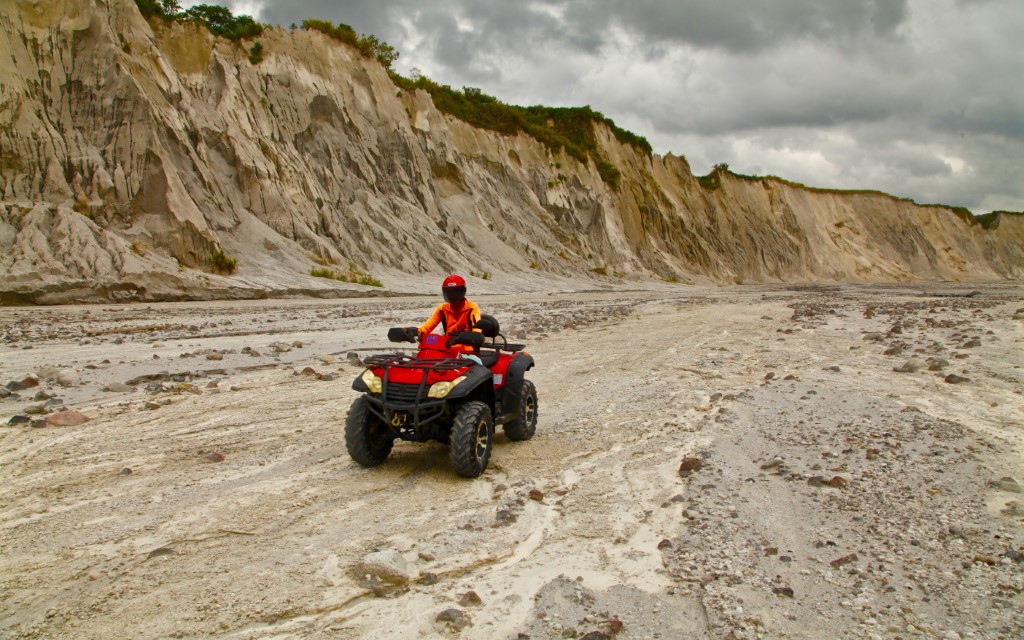
Ten minutes later I hit Clark. Now a Special Economic Zone, Clark is a hub for IT, aviation and gambling, and is unlike other places I’ve seen in the Philippines. There are sports fields, parks and people jogging and walking dogs, and the streets are spotlessly clean. There’s even free citywide WiFi! It’s the American dream come true in the tropics.
I spend the night at Santa Juliana, the closest remaining village to Mount Pinatubo. The next morning I rise at dawn and ride to the office of Capas ATV Adventures where I swap my Beamer for an ATV. The plan: to ride an ATV into the crater of the now dormant volcano.
My guide, Walter, gives me three rules before we depart: “No overtaking, no exhibitionism and definitely no drifting”. Yet the terrain, a wide, shallow delta riddled with sandbanks, is almost made for drifting. Within a few minutes, I’m drifting more than I am not drifting. Walter acknowledges the fact that I look like I know how to drift (even though it’s my second time on an ATV and I’m learning on the job) and lets the infraction slide.
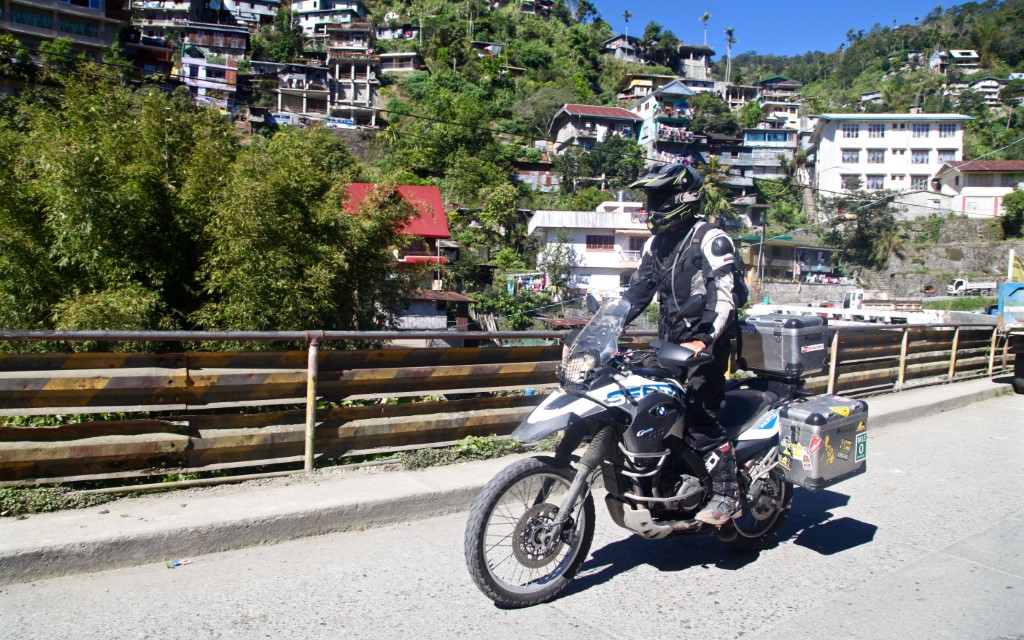
Onwards we charge through rain and wind into a narrow canyon where the going gets so rough we have to ditch the ATVs and walk. Now, if there’s one thing I hate as much as I love riding, it’s trekking. And this trek is three miles long, uphill most of the way and takes two bloody hours in my chunky motocross boots.
But when we reach the crater all is forgotten as I stare in wonder at the sight before my eyes. From where I’m standing, the giant crater walls appear to bend inwards like a giant stone wave, while the lake that has formed in the middle over the past 25 years is so large it produces actual waves. And with a depth of 600m, it’s also the deepest lake in the Philippines.
#Ishouldbedead
That’s the hashtag I use on social media to let my friends and family back home know I’m still alive after riding 230 miles from Santa Juliana to Banaue in seven straight hours on day three of my Filipino Fling.
Things begin beautifully as I coast up a near-empty motorway under big blue skies. But when the toll road ends my GPS reroutes me to the Pan-Philippines Highway, a network of roads, bridge and ferries that connects the country’s major islands and accounts for a fair slug of the Philippines’ 10,000-odd annual road fatalities.
In this part of Luzon, the Pan-Philippines Highway is a two-lane road used by pedestrians, bike riders, barnyard animals, tractors and cars alike. The most popular vehicles are ‘tricycles’, a Filipino version of the auto-rickshaw, essentially a 150cc Jap motorbike with a large covered sidecar.
I see one carrying 10 people. Three on the bike, five in the sidecar and two kids on the roof. I see another tricycle lugging a cow. Tricycles are slow, painfully slow, plodding along at 12mph. And because there are only two busy lanes, the rickshaws in their slowness create slow-moving columns of cars, trucks and buses that can’t overtake them and reduce every vehicle’s speed to 12mph.
These columns create a dilemma for me. If I wait patiently for safe overtaking opportunities, it’ll take me much more time to reach my destination. The longer I remain on the road, the greater my chances of becoming roadkill. But if I start taking risks and overtaking around semi-blind corners, the risk increases even further.
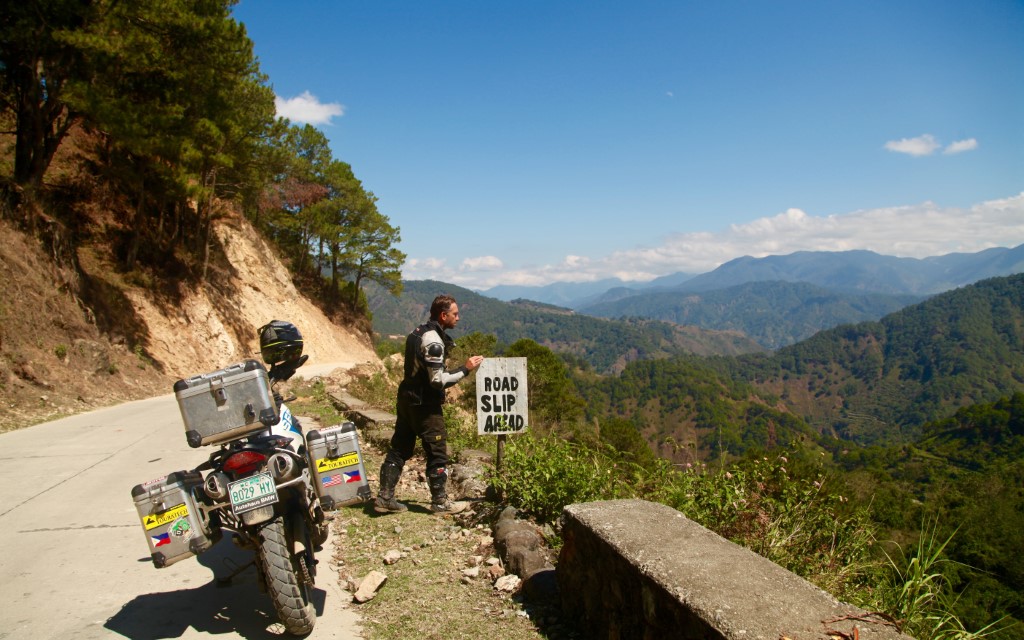
So I play it safe, riding conservatively without a breeze as I cook in my body armour under the tropical sun. Within 10 minutes I can take no more. Channelling my inner Crusty Demons, I start weaving and bobbing through the traffic like a bat out of hell, aerating my jacket with the hot breeze.
But every time I hit a town I get stuck in a mini-Manila traffic jam, sandwiched between buses or railroaded by tricycle drivers who complete u-turns or merge without looking back. The ride isn’t fun. It’s basic instinct and survival.
After three hours on the road the traffic begins to thin and the highway curves up the steep end of a mountain range before dropping like a bomb into a lush green plain chequered with paddy fields. After five hours I reach the town of Kalusnan, where I exit the Pan-Philippines Highway and begin climbing the Cordillera Central, the highlands of northern Luzon.
I ride over steel bridges connecting deep ravines, under towering limestone formations and past villages lined with woodwork shops until, after seven hours on some of the world’s most dangerous roads, I reach Banaue. I’m soaked in my own sweat and #ishouldbedead, but I’m not. Time to party.
Imelda and Dax to the rescue
The next day I wake up late and stroll out onto my balcony. Like many buildings in Banaue, my hotel literally hugs a cliff that falls into a ravine with a raging river running below it. I light a cigarette and rub my head. It hurts.
Last night, after a sensationally good and cheap chicken adobo dinner, I got talking to a couple of Canadian girls. We had a few drinks in the restaurant and then moved on to a reggae bar where the barman poured us Tanduay Rhum and Cokes that were 50% rum and 50% Coke. Ergo the chronic hangover, though it’s nothing some bacon and eggs can’t sort out.
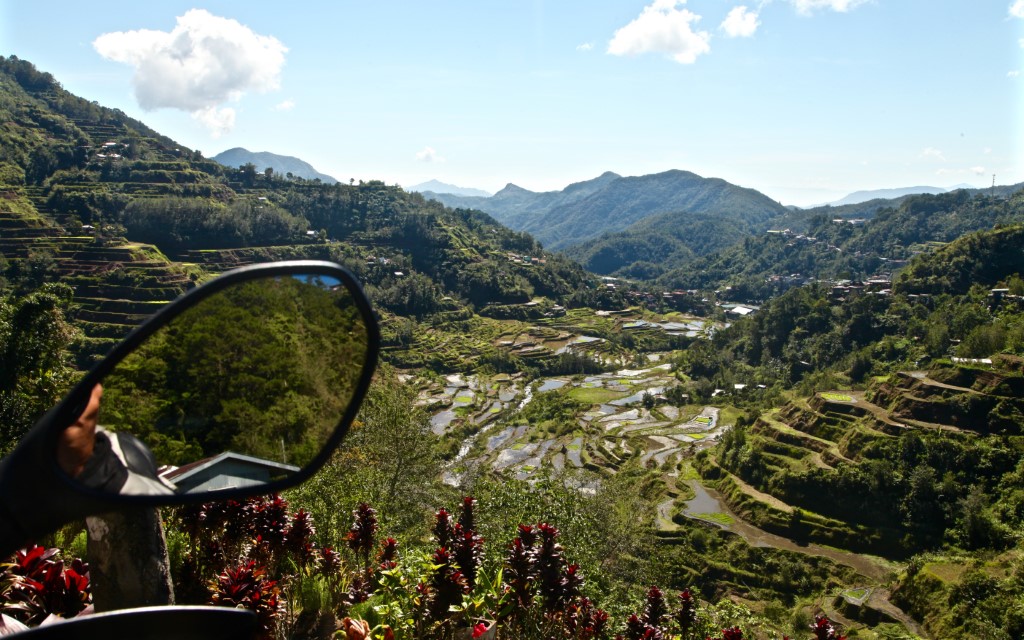
My mission today is to see the Ifugao Rice Terraces, the ‘eighth wonder of the world’, a 2,000-year-old engineering marvel built to maximise the use of farming land in the thickly forested ranges and deep valleys surrounding Banaue. The most picturesque of these terraces surround a village called Batad 12 miles to the north. The ride is short but magical and when I reach Batad Saddle Point I park my bike at a roadside restaurant for what I’m told is a half-hour hike to Batad.
Yet somewhere along the walking trail I take a wrong turn and end up crawling down 200m high terraces on my hands and knees, cutting through malarial-infested rice paddies and bashing through six-foot-tall elephant grass like a bloody Viet Cong. I march along in 35C heat, hating every fucking second of it, drinking from little waterfalls that spring from rock walls so I don’t die of dehydration until after three hours of walking blindly, I reach the village of Batad.
But it’s not Batad, the village folk tell me in broken English. It’s a totally different village, and “Batad is that way”, says one dude who reeks of home-brew. “No it’s the other way,” says a second dude who’s also obviously had a few. “No it’s back that way,” says a third.
Then a pack of dogs start barking so loudly I can’t hear myself think let alone the villagers talk, so I give up and walk off. On the village’s outskirts I meet Imelda, an eighth grade student and suave businesswoman who offers to guide me to a road where I can get a tricycle back to Saddle Point, for $20. I bargain her down to $10 and we set off, but alas she goes the wrong way. Fifteen minutes later we’re back where we started yet this time Imelda is sure of her bearings.
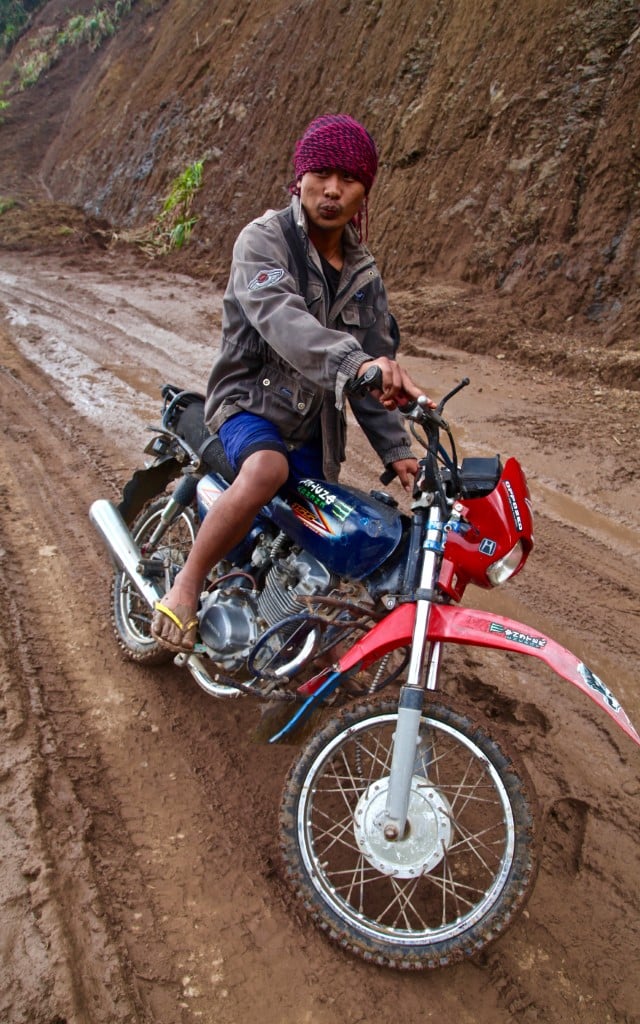
An hour later, we pop out onto a muddy road where we walk another 20 minutes to the home of Imelda’s uncle, who she says has a tricycle. But her uncle’s not home. Instead we’re greeted by Imelda’s 16-year-old cousin Dax who offers to take me to Saddle Point on the back of a rusty old Chinese 150cc motorbike held together with spit and glue, for $20. I bargain him down to $10, pay Imelda the $10 I owe her and we head off.
Now, Dax knows how to ride but he can’t handle the deep muddy ruts while carrying a 90kg passenger on the back. Within a minute of taking off, we both end up face down in mud. We try again but with the same result, so I ask Dax to let me drive. He’s hugely relieved and screams like a banshee as I carve a line through the ruts. It’s dusk when we get back to the Beamer and dark when I get back to Banaue, where I head straight for the reggae bar, covered in dirt and mud, for a few seriously stiff drinks.
Sea of clouds
After two nights in Banaue, I ride to Sagada, a hillside resort set around a subtropical canyon honeycombed with caves and waterfalls where the locals hang coffi ns, with corpses inside them, on sheer cliff faces! Sagada was also a hippy hangout back in the ‘70s and ‘80s and there are still a few old hippies hanging around.
I meet one called Babu Hanuman, a German national who looks like Gandalf the Grey, except instead of living in a castle he lives in a hut made of cow dung surrounded by vast marijuana fields. Babu introduces me to another German hippy called George who lives in a log cabin in the woods where he makes his own sausages and gin. After seeing my Beamer, he tells me of an old Boxer Twin he owned during his former life as a high-powered chef in Hamburg.
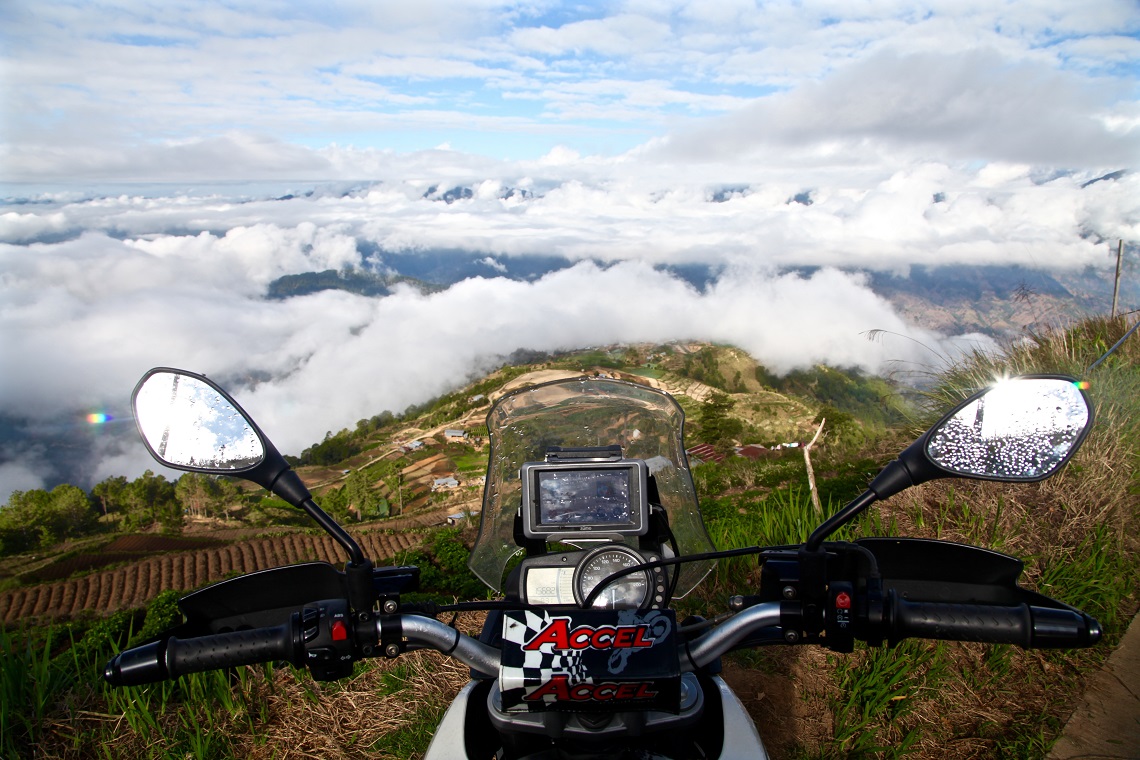
We swap a few bike stories and he invites me to stay for lunch, which becomes dinner, and I end up staying the weekend, eating, drinking and smoking with Babu Hanuman, George and a permanent stream of smiling, friendly, happy Filipino visitors whose sole aim in life is to party.
The ride back to Manila is much more fun than the ride up. I forgo the Pan-Philippines Highway and instead take a series of backcountry roads riddled with twisties and switchbacks. The highland scenery is stunning, with great valleys and towering peaks layered with tropical pines and little villages clinging to cliffs and hills. It looks remarkably like Switzerland, except the cars are a thousand times crappier and nearly every house here is only half-built. “They can live in it already. Let’s go party and come back and finish this job later on.”
I spend my seventh and last night on the road at a village near the peak of Mount Pulag, which at 2,922m is Luzon’s highest point. Climbers from all over the world came here for the five-hour trek to the summit. But I have no intention of walking up another bloody mountain, not for five minutes let alone five bloody hours.
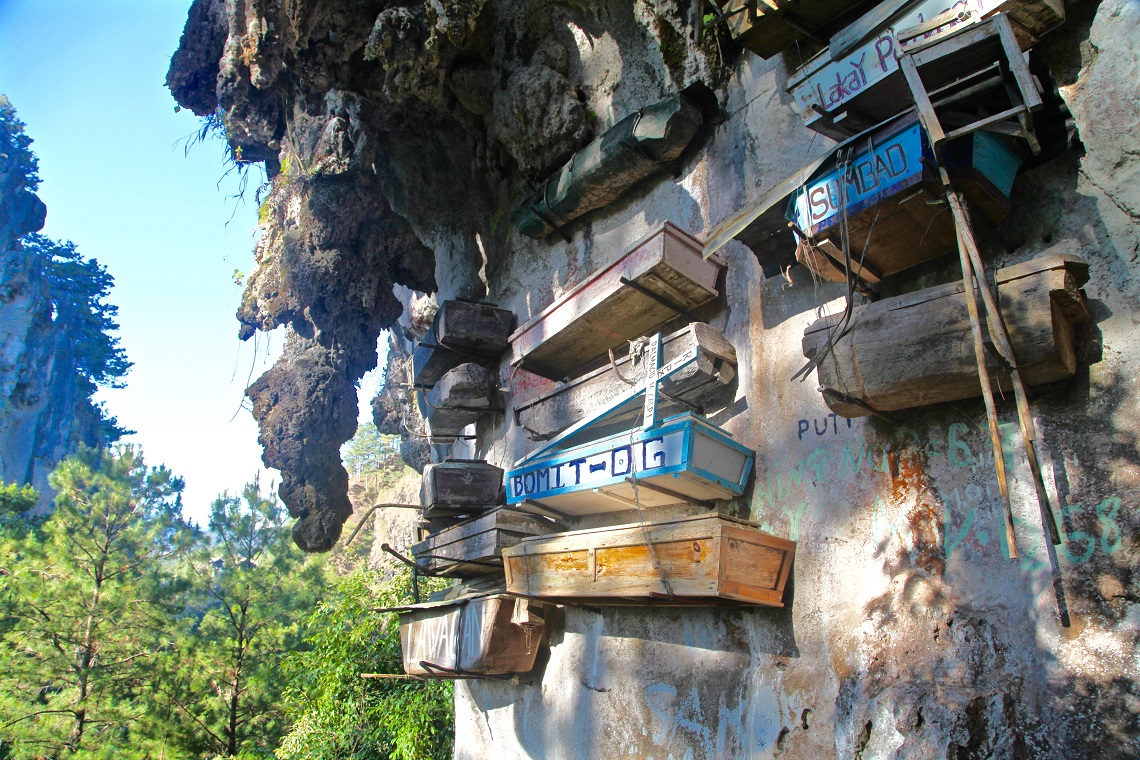
I came solely for the clifftop single track road that got me to the top, and the views awarded therein. Known for a ‘sea of clouds’ phenomenon where lower-lying peaks and crags are visible through gaps in the clouds and mist, Mount Pulag is all fluffy and white and green with sturdy little super-friendly mountain people. It’s a little piece of heaven on earth, and I never would have found it if I had ‘stayed in my lane’.
“Some riders come here and want things to run according to their pre-defined plan, but that contradicts what it means to be in the Philippines,” says Philippe of PAR Motorrad. “Yet if you have a spirit of adventure and you love motorbikes, then this is the right place is for you.”
Want to ride in the Philippines? Here’s how you can…
Getting there
Philippine Airlines (philippineairlines.com) flies five times a week from London to Manila from approximately £930 return.
Staying there
Hotel Jen (hoteljen.com/ manila) on Manila’s waterfront has rooms from £68 per night. In Santa Juliana, Allan Bognot’s Guesthouse (see Tripadvisor) has rooms for £31. In Banaue, Uyami’s Greenview Lodge (ugreenview.wordpress.com) charges £20 a night for rooms. In Sagada, stay at the Saint Joseph Guesthouse (see Tripadvisor) for £4.80 a night. At Mount Pulag, Baban’s Homestay (see Facebook) has dorm beds for £4.80 per night.
Bike rental
In 2005, Philippe Sauvier, a Frenchman living in the Philippines, suffered a massive heart attack on a plane. The next day while recovering in hospital, he created a bucket list of all the things he wanted to do before he died. Buying a dirt bike topped it. Philippe travelled to California for an off-road learner’s course and spent many a weekend over the next few years riding a Honda XR200 around the islands of his adopted home. In 2013, he bought a fleet of brand new BMW adventure bikes and launched PAR Motorrad, the Philippines’ first professional motorbike touring company.
PAR Motorrad offers guided tours taking in the highlands, volcanoes, beaches, historical sites and islands of the Philippines. Sevenday tours start at US$1,498 (approximately £1039) and climb up to US$4,424 (approximately £3070) for a 20-day tour. Straight rentals are available for US$105 (£72) per day. A two-hour brief with Philippe before you set off is US$115 (£79).
For more info visit www.parmotorrad.com or call on +63 999 993 5166.
ATV hire
Capas ATV Adventure offer day trips into Mount Pinatubo crater for $267 (£185) per vehicle (up to two persons per vehicle). Volcano entry fees are $13 (£9) per person.
Travelling in the Philippines
Documents
Passport, no visa, 30 days
Vaccinations
Diphtheria, MMR (measles, mumps, rubella), Typhoid and Hepatitis A.
Language
English/Tagalog
Currency
Philippine Peso
Where to go
More sights and activities
- Intramuros, the old city of Manila.
- Diving in the lagoon lakes of Coron Island.
- Climbing Mt Pulag.
- Cave connection tour in Sagada.
- The Ifugao Rice Terraces.
- Kitesurfing on the island of Boracay
When To Go – The dry season in the Philippines starts in January and ends in June. The rest of the year it rains cats and dogs and touring is not advised.
Tipping
- Most hospitality staff in the Philippines earn less than $5 a day. Tipping isn’t compulsory, but a buck or two in the hands of a bell boy or waiter will make their day.
- Taxi meters are set. Again, small tips are greatly appreciated.
- 20-100 pesos for a bell boy is sufficient.
Foods & Drinks To Try
- Chicken Adobo – the Filipino national dish prepared with garlic, vinegar, coconut milk and soy sauce. Eaten with mounds of rice.
- Jollibee – the Philippines’ own version of McDonald’s with more than 750 stores nationwide. Do you want rice with your burger?
- Lechon – the party food in the Philippines. A spit-roasted baby pig served with liver sauce – or not!
- Tanduay Rhum – a locally made sweet dark rum that goes down like the Titanic with ice and Coke after a long day on the road.
The Law
Traffic law enforcement is virtually non-existent in the Philippines. Be wary of solicitations from underage girls in cities. Some rural areas have indigenous laws that require local knowledge on what kind of behaviour is and isn’t allowed.
Punctuality
Planes and public transport in the Philippines normally always run late. The traffic in Manila is horrendous and getting anywhere on time is a challenge. In the provinces and on smaller islands, the hours of the day have little meaning

